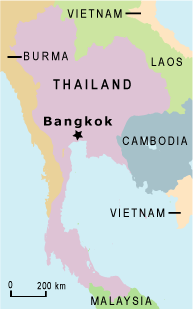In order to develop the rural areas of countries such as Thailand, families and communities often depend on the money and goods sent home by relatives with jobs in cities, such as Bangkok. Two different theoretical models, depending on the country under examination, have been described in the social science literature to explain the behavior of workers in cities who provide assistance to their rural relatives.
One model suggests that remittances from the city to rural families are based on altruism: people with available funds are responding to the needs of other members of their households. This model includes the implication that senders remit more or less support depending on the actual income of the rural households where they came from. It also carries the implication that the amount of support the migrants provide depends on the level of their own income. Levels of altruistic remittances also depend on factors such as the presence in the rural households of children or elderly people.
A different theoretical model suggests that remittances really represent an implicit contractual arrangement, which could also be characterized as “enlightened self-interest” or “tempered altruism.” Scholars who support this model point to the fact that rural households often loan funds to the migrants so they can go off and get an education. In return, the migrants are expected to remit funds back to the households later. Another argument supporting this contractual model is that the migrant and the household of origin normally are in different geographical locations and they pursue different economic endeavors, so in times of financial difficulties, both are not likely to suffer hardships. Thus, their economic differences act, in a contractual fashion, as coinsurance for one other.
 Leah VanWey recently examined these two models of migrant remittance behavior—altruistic versus contractual—in Rural Thai households. She included in her research an additional focus on gendered differences in these relationships. Her sample of 4045 male migrants and 3300 female migrants represented, respectively, 28 percent and 22 percent of the residents from the sampled households of 51 villages in rural Northeast Thailand. While that section of the country depends on rice as the major crop, some cassava cultivation and other horticulture supplements the basic rice-farming economy. Migration to major cities for jobs, and remittances back to the rural families, has long been an important behavior pattern in that area. In fact, more remittances are sent back to Northeast Thailand than to any other region of the country.
Leah VanWey recently examined these two models of migrant remittance behavior—altruistic versus contractual—in Rural Thai households. She included in her research an additional focus on gendered differences in these relationships. Her sample of 4045 male migrants and 3300 female migrants represented, respectively, 28 percent and 22 percent of the residents from the sampled households of 51 villages in rural Northeast Thailand. While that section of the country depends on rice as the major crop, some cassava cultivation and other horticulture supplements the basic rice-farming economy. Migration to major cities for jobs, and remittances back to the rural families, has long been an important behavior pattern in that area. In fact, more remittances are sent back to Northeast Thailand than to any other region of the country.
VanWey’s analysis of the responses to her thousands of questionnaires shows that both altruistic and contractual characteristics apply to the remittance behaviors of the Rural Thai migrants. Numerous predictors from the altruistic model, such as relationships between the needs of the households and the incomes of the migrants, tend to confirm that model. Other predictors of the altruistic model also appear in her results, such as the positive effects of children or elderly persons in the households on the remittance responses of the migrants.
However, some of her results relating to the occupations and the educations of the migrants also support the contractual model. Since the results from her analysis of the data are mixed, she concludes that the situation is quite complex. She does believe that her data gives somewhat greater support for the contractual model than for the altruistic one.
To qualify that result, however, she shows that the gender of the migrant makes a significant difference. In several measures, she finds more altruistic than contractual behavior patterns among female than among male migrants who send support back to their rural villages. These results are not surprising, since the beliefs of Theravada Buddhism in rural Thailand emphasize that women acquire religious merit for their families by helping to support them. However, other scholars have found evidence that there may be additional explanations for the different characteristics of remittances by rural Thai women as compared to men. Ethnographic evidence suggests that rural Thai households may be more reluctant to allow their daughters to migrate than their sons. That may result in female migrants sending money as payments for allowing them to leave.
VanWey emphasizes that her research does not address the motivations of the migrants in providing support to their rural households. She suggests that altruistic behavior could just as well stem from a coercive milieu as from positive feelings within the household. Whatever the motivations may be, her research provides fresh insights into the relationships between Rural Thai households and the people who migrate out for education and income-producing jobs.
VanWey, Leah K. 2004. “Altruistic and Contractual Remittances between Male and Female Migrants and Households in Rural Thailand.” Demography 41(4): 739-756.